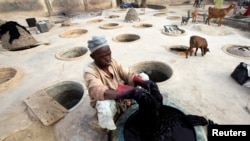For at least five centuries, people in the northern Nigerian city of Kano have dyed cloth in open-air pits and sold it across the region. But the dye pits’ business is fading. Artisans blame the region’s ongoing insecurity, particularly the Boko Haram insurgency, for the decline.
Sitting near one of the Kofar Mata dye pits, Mamuda Abubakar sinks cotton cloth into a brew of water, indigo, ash and potassium. Later, he pulls out a deep blue garment that will be offered for sale at the Kofar Dye Pits in Kano’s old city.
Abubakar has been an indigo dyer for decades. His relatives have been in the business for over a century, and the Kano Matar pits themselves date to 1498, a sign says. But while his dedication to the trade has changed little, customer interest has changed significantly.
Customers used to be plentiful here, Abubakar says. Now, they don’t come nearly as often.
Kano, a cultural center for the Hausa ethnic group, has long dealt with periodic unrest. But violence in the country’s north, especially by the Islamist militants of Boko Haram, has scared away investors and tourists. Many foreign embassies advise against travel to Kano state.
A dyeing business
The drop in Western tourists and regional traders is hastening the local trade’s decline, says Alhaji Audu Uba, emir of the dye pits.
He says unrest in the country’s north from Boko Haram has hurt business. Foreigners used to come to buy cloth from the dye pits, but they don’t show up anymore, he says.
Families own each of the 144 pits here, and ownership has been passed down through generations. But many lie abandoned and filled with trash, which the owners would need to clean out before they could continue dying.
Abubakar Inuwa is among the younger people working on a Sunday. He splits his time between dyeing fabric and ironing, which he does by throwing garments over a log and whacking out the wrinkles with a big piece of mahogany.
Many of Inuwa’s peers see his job as an unprofitable throwback to a bygone era.
"They see it as a local occupation, but this work we are doing is big work," he said. "If they take it as very important," it will expand.
The dye pits’ decline mirrors Kano’s own troubles.
Nigeria – Africa’s most populous country, with 170 million residents – last year emerged as having its largest economy. But Kano boasts little of the same development as the largest city Lagos or the capital Abuja, in part because of the continued unrest in the north.
Those who work here say that without peace in the north, there’s little chance the dye pits will become profitable again anytime soon.








